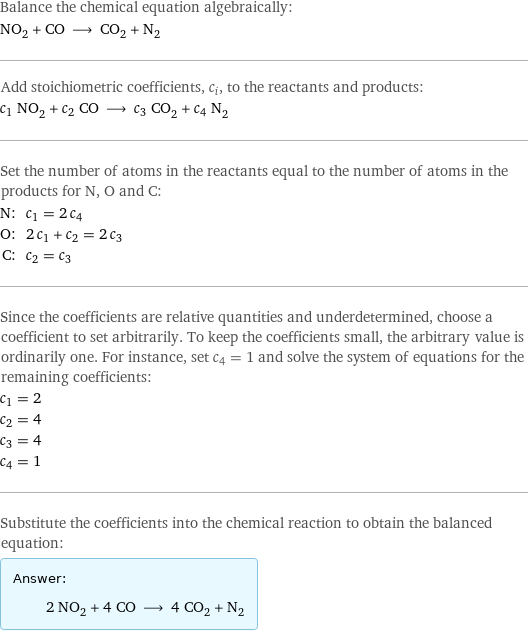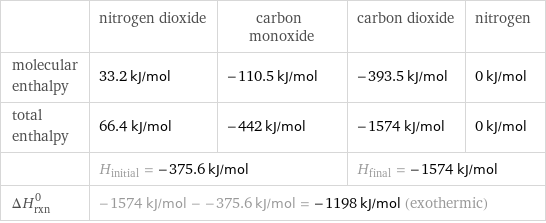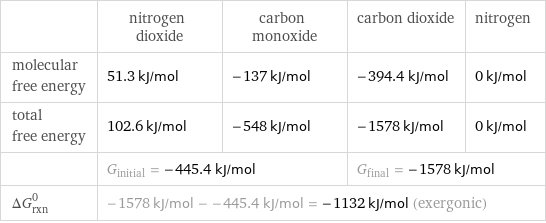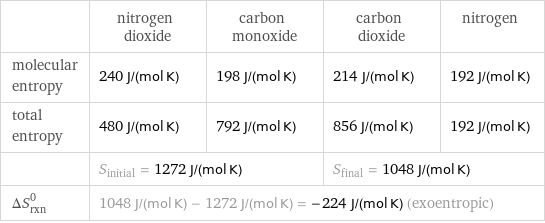Input interpretation

NO_2 nitrogen dioxide + CO carbon monoxide ⟶ CO_2 carbon dioxide + N_2 nitrogen
Balanced equation

Balance the chemical equation algebraically: NO_2 + CO ⟶ CO_2 + N_2 Add stoichiometric coefficients, c_i, to the reactants and products: c_1 NO_2 + c_2 CO ⟶ c_3 CO_2 + c_4 N_2 Set the number of atoms in the reactants equal to the number of atoms in the products for N, O and C: N: | c_1 = 2 c_4 O: | 2 c_1 + c_2 = 2 c_3 C: | c_2 = c_3 Since the coefficients are relative quantities and underdetermined, choose a coefficient to set arbitrarily. To keep the coefficients small, the arbitrary value is ordinarily one. For instance, set c_4 = 1 and solve the system of equations for the remaining coefficients: c_1 = 2 c_2 = 4 c_3 = 4 c_4 = 1 Substitute the coefficients into the chemical reaction to obtain the balanced equation: Answer: | | 2 NO_2 + 4 CO ⟶ 4 CO_2 + N_2
Structures

+ ⟶ +
Names

nitrogen dioxide + carbon monoxide ⟶ carbon dioxide + nitrogen
Reaction thermodynamics
Enthalpy

| nitrogen dioxide | carbon monoxide | carbon dioxide | nitrogen molecular enthalpy | 33.2 kJ/mol | -110.5 kJ/mol | -393.5 kJ/mol | 0 kJ/mol total enthalpy | 66.4 kJ/mol | -442 kJ/mol | -1574 kJ/mol | 0 kJ/mol | H_initial = -375.6 kJ/mol | | H_final = -1574 kJ/mol | ΔH_rxn^0 | -1574 kJ/mol - -375.6 kJ/mol = -1198 kJ/mol (exothermic) | | |
Gibbs free energy

| nitrogen dioxide | carbon monoxide | carbon dioxide | nitrogen molecular free energy | 51.3 kJ/mol | -137 kJ/mol | -394.4 kJ/mol | 0 kJ/mol total free energy | 102.6 kJ/mol | -548 kJ/mol | -1578 kJ/mol | 0 kJ/mol | G_initial = -445.4 kJ/mol | | G_final = -1578 kJ/mol | ΔG_rxn^0 | -1578 kJ/mol - -445.4 kJ/mol = -1132 kJ/mol (exergonic) | | |
Entropy

| nitrogen dioxide | carbon monoxide | carbon dioxide | nitrogen molecular entropy | 240 J/(mol K) | 198 J/(mol K) | 214 J/(mol K) | 192 J/(mol K) total entropy | 480 J/(mol K) | 792 J/(mol K) | 856 J/(mol K) | 192 J/(mol K) | S_initial = 1272 J/(mol K) | | S_final = 1048 J/(mol K) | ΔS_rxn^0 | 1048 J/(mol K) - 1272 J/(mol K) = -224 J/(mol K) (exoentropic) | | |
Equilibrium constant
![Construct the equilibrium constant, K, expression for: NO_2 + CO ⟶ CO_2 + N_2 Plan: • Balance the chemical equation. • Determine the stoichiometric numbers. • Assemble the activity expression for each chemical species. • Use the activity expressions to build the equilibrium constant expression. Write the balanced chemical equation: 2 NO_2 + 4 CO ⟶ 4 CO_2 + N_2 Assign stoichiometric numbers, ν_i, using the stoichiometric coefficients, c_i, from the balanced chemical equation in the following manner: ν_i = -c_i for reactants and ν_i = c_i for products: chemical species | c_i | ν_i NO_2 | 2 | -2 CO | 4 | -4 CO_2 | 4 | 4 N_2 | 1 | 1 Assemble the activity expressions accounting for the state of matter and ν_i: chemical species | c_i | ν_i | activity expression NO_2 | 2 | -2 | ([NO2])^(-2) CO | 4 | -4 | ([CO])^(-4) CO_2 | 4 | 4 | ([CO2])^4 N_2 | 1 | 1 | [N2] The equilibrium constant symbol in the concentration basis is: K_c Mulitply the activity expressions to arrive at the K_c expression: Answer: | | K_c = ([NO2])^(-2) ([CO])^(-4) ([CO2])^4 [N2] = (([CO2])^4 [N2])/(([NO2])^2 ([CO])^4)](../image_source/6c68acc795e477fc1fd9d32febd3f642.png)
Construct the equilibrium constant, K, expression for: NO_2 + CO ⟶ CO_2 + N_2 Plan: • Balance the chemical equation. • Determine the stoichiometric numbers. • Assemble the activity expression for each chemical species. • Use the activity expressions to build the equilibrium constant expression. Write the balanced chemical equation: 2 NO_2 + 4 CO ⟶ 4 CO_2 + N_2 Assign stoichiometric numbers, ν_i, using the stoichiometric coefficients, c_i, from the balanced chemical equation in the following manner: ν_i = -c_i for reactants and ν_i = c_i for products: chemical species | c_i | ν_i NO_2 | 2 | -2 CO | 4 | -4 CO_2 | 4 | 4 N_2 | 1 | 1 Assemble the activity expressions accounting for the state of matter and ν_i: chemical species | c_i | ν_i | activity expression NO_2 | 2 | -2 | ([NO2])^(-2) CO | 4 | -4 | ([CO])^(-4) CO_2 | 4 | 4 | ([CO2])^4 N_2 | 1 | 1 | [N2] The equilibrium constant symbol in the concentration basis is: K_c Mulitply the activity expressions to arrive at the K_c expression: Answer: | | K_c = ([NO2])^(-2) ([CO])^(-4) ([CO2])^4 [N2] = (([CO2])^4 [N2])/(([NO2])^2 ([CO])^4)
Rate of reaction
![Construct the rate of reaction expression for: NO_2 + CO ⟶ CO_2 + N_2 Plan: • Balance the chemical equation. • Determine the stoichiometric numbers. • Assemble the rate term for each chemical species. • Write the rate of reaction expression. Write the balanced chemical equation: 2 NO_2 + 4 CO ⟶ 4 CO_2 + N_2 Assign stoichiometric numbers, ν_i, using the stoichiometric coefficients, c_i, from the balanced chemical equation in the following manner: ν_i = -c_i for reactants and ν_i = c_i for products: chemical species | c_i | ν_i NO_2 | 2 | -2 CO | 4 | -4 CO_2 | 4 | 4 N_2 | 1 | 1 The rate term for each chemical species, B_i, is 1/ν_i(Δ[B_i])/(Δt) where [B_i] is the amount concentration and t is time: chemical species | c_i | ν_i | rate term NO_2 | 2 | -2 | -1/2 (Δ[NO2])/(Δt) CO | 4 | -4 | -1/4 (Δ[CO])/(Δt) CO_2 | 4 | 4 | 1/4 (Δ[CO2])/(Δt) N_2 | 1 | 1 | (Δ[N2])/(Δt) (for infinitesimal rate of change, replace Δ with d) Set the rate terms equal to each other to arrive at the rate expression: Answer: | | rate = -1/2 (Δ[NO2])/(Δt) = -1/4 (Δ[CO])/(Δt) = 1/4 (Δ[CO2])/(Δt) = (Δ[N2])/(Δt) (assuming constant volume and no accumulation of intermediates or side products)](../image_source/dd509e8386669dcf81b9c350bf7d3f9d.png)
Construct the rate of reaction expression for: NO_2 + CO ⟶ CO_2 + N_2 Plan: • Balance the chemical equation. • Determine the stoichiometric numbers. • Assemble the rate term for each chemical species. • Write the rate of reaction expression. Write the balanced chemical equation: 2 NO_2 + 4 CO ⟶ 4 CO_2 + N_2 Assign stoichiometric numbers, ν_i, using the stoichiometric coefficients, c_i, from the balanced chemical equation in the following manner: ν_i = -c_i for reactants and ν_i = c_i for products: chemical species | c_i | ν_i NO_2 | 2 | -2 CO | 4 | -4 CO_2 | 4 | 4 N_2 | 1 | 1 The rate term for each chemical species, B_i, is 1/ν_i(Δ[B_i])/(Δt) where [B_i] is the amount concentration and t is time: chemical species | c_i | ν_i | rate term NO_2 | 2 | -2 | -1/2 (Δ[NO2])/(Δt) CO | 4 | -4 | -1/4 (Δ[CO])/(Δt) CO_2 | 4 | 4 | 1/4 (Δ[CO2])/(Δt) N_2 | 1 | 1 | (Δ[N2])/(Δt) (for infinitesimal rate of change, replace Δ with d) Set the rate terms equal to each other to arrive at the rate expression: Answer: | | rate = -1/2 (Δ[NO2])/(Δt) = -1/4 (Δ[CO])/(Δt) = 1/4 (Δ[CO2])/(Δt) = (Δ[N2])/(Δt) (assuming constant volume and no accumulation of intermediates or side products)
Chemical names and formulas

| nitrogen dioxide | carbon monoxide | carbon dioxide | nitrogen formula | NO_2 | CO | CO_2 | N_2 name | nitrogen dioxide | carbon monoxide | carbon dioxide | nitrogen IUPAC name | Nitrogen dioxide | carbon monoxide | carbon dioxide | molecular nitrogen